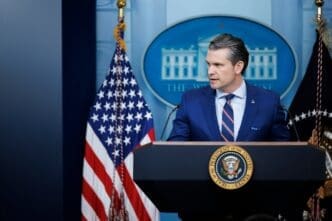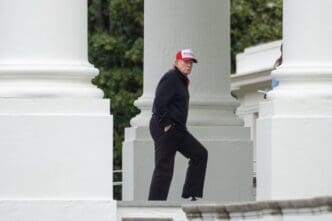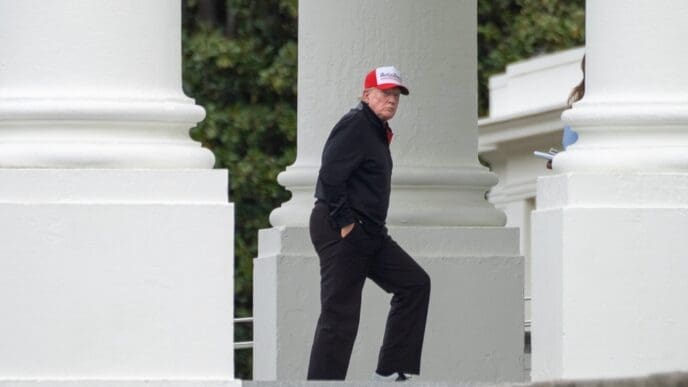U.S. Defense Secretary Pete Hegseth emphasized Japan’s critical role as an “indispensable partner” in countering China’s growing assertiveness in the region. On Sunday, during his first trip to Asia with Japan as his second stop, Hegseth announced an upgrade of the U.S. military command in Japan, transforming it into a “war-fighting headquarters.”
Hegseth underscored the urgency for both nations to enhance their military capabilities amidst China’s assertive military posture and the potential for a Taiwan crisis. “Japan is our indispensable partner in deterring Communist Chinese military aggression,” declared Hegseth at the onset of his discussions with Japan’s Defense Minister, Gen Nakatani, in Tokyo. “The U.S. is moving fast, as you know, to reestablish deterrence in this region and around the world.”
These statements are intended to reassure Japan amid concerns about U.S. engagement changes under President Donald Trump’s “America First” policy, according to anonymous Japanese defense officials. Trump’s threats to impose trade tariffs on Japan, a crucial ally, have added to these concerns.
The two countries have agreed to expedite the joint development and production of missiles, such as the Advanced Medium-Range Air-to-Air Missiles (AMRAAM), and consider producing SM-6 surface-to-air missiles to alleviate munitions shortages, informed Nakatani. Additionally, they committed to hastening the maintenance processes for U.S. warships and aircraft in Japan, bolstering both American and Japanese defense industries.
In July, under the Biden administration, Japan and the U.S. decided to enhance the command and control structures of the Japanese military and U.S. forces based in Japan. This major structural shift aims to strengthen joint operational and response capabilities, with Japan hosting over 50,000 U.S. troops.
Last week, Tokyo introduced the Japan Joint Operations Command (JJOC) to coordinate Ground, Maritime, and Air Self-Defense Forces, further solidifying its capacity to handle emergencies and collaborate effectively with the U.S.
On Sunday, Hegseth announced the elevation of the existing U.S. Forces Japan command to a unified operational command, serving as a joint force headquarters. This new “war-fighting headquarters” will enhance troop cooperation and operational speed with their Japanese counterparts. Hegseth emphasized the necessity to be ready for potential conflicts, asserting, “America and Japan both work for peace, but we must be prepared.”
Japanese defense officials do not anticipate significant changes in their obligations or an increase in U.S. troop numbers. At a joint news conference, Hegseth and Nakatani agreed to bolster Japan’s defense on the Southwestern islands, strategically located near disputed East China Sea territories and Taiwan, to heighten deterrence against China.
Hegseth stressed the need for “sustaining, robust, ready, and credible deterrence” in the Indo-Pacific, especially across the Taiwan Strait, noting Japan’s frontline position in any western Pacific contingency. China claims Taiwan as its territory, while the U.S., under a 1979 law, is obliged to supply Taiwan with adequate military hardware and technology to deter invasion. This has consistently provoked strong opposition from Beijing.
On Saturday, Hegseth participated in a U.S.-Japan joint memorial commemorating the 80th anniversary of the Battle of Iwo Jima, a fierce World War II encounter, celebrating the robust alliance between the former adversaries. Prior to his Japan visit, Hegseth visited the Philippines, reaffirming Trump’s commitment to strengthening ties with the Southeast Asian nation amid its maritime disputes with Beijing.
The Evolving Landscape
- The military cooperation between the U.S. and Japan signals a reinforced commitment to regional stability, potentially affecting diplomatic and economic relations in East Asia.
- The upgraded U.S. military command in Japan might influence regional security dynamics, particularly concerning China’s territorial ambitions.
- Enhanced military capabilities in Japan could lead to increased security and defense spending, impacting national budgets and economic strategies.
- Local communities hosting U.S. troops may experience changes due to increased military presence or activities, affecting daily life and local economies.
- The joint development of missiles and defense technologies may create job opportunities and promote technological advancements within the defense sector.
- Heightened regional tensions could affect international trade routes and economic stability, influencing global markets and consumer prices.














